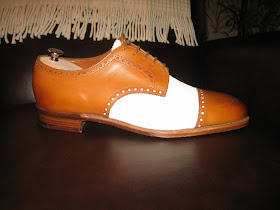The ever-versatile spectator shoe:
The Duke of Windsor kicks off a Bahamian rugby match
during his tenure as the island's Governor, early 1940s.
When Ralph Lauren tasked Edward Green with the job of creating a traditional full brogue spectator, the Hutton seemed to have all the bases covered: dark oak calf leather with white suede accenting the full broguing, touched off with dark sole edges that subtly emphasized the vibrant interplay of light and dark tones at work on the uppers. Essentially, a classic look designed to put you at ease on the golf course or a summer wedding.
Perhaps fearing that the Hutton might not be versatile enough to cover the full range of sartorial events that an uptown dandy might be expected to attend in one spring/summer season, Ralph Lauren doubled down and commissioned Edward Green's production of the Whitaker, a semi-brogue, or captoe, spectator shoe on the 89 last (derived from Edward Green's Cardiff model).
This time, the dark oak leather calf was replaced with the lighter, almost golden "edwardian antique" color that again playfully contrasts against the lovely white suede leather. On the Whitaker model, you can see that while some of the broguing is highlighted by the white suede that frames the punching (along the captoe, for instance), in other instances the broguing remains "monotone" or without the contrasting color scheme (the broguing remaining in the edwardian antique color).
This particular model was given a more informal, casual look by pairing the vibrant leather patina of the edwardian antique color with a natural edge heel and sole. Overall, I find the effect quite pleasing to the eye.
Here are a few additional photos minus the flash - its hard to say which set of photos are more "accurate" with regards to the edwardian antique color.
Ultimately, if you're looking to justify multiple pairs of spectators in your closet, varying the "dark" leather color is a good place to start. The sole edge treatment is also helpful, as the dark brown or black "sole edging" treatment really changes the entire complexion of the shoe vis-a-vis the "natural" sole edge treatment. While I try to keep it real with the white suede, there are certainly other color and fabric options available if you want to broaden your horizons as you delve deeper into the world of spectators.







No comments:
Post a Comment